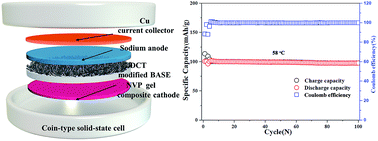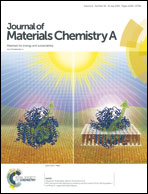Disordered carbon tubes based on cotton cloth for modulating interface impedance in β′′-Al2O3-based solid-state sodium metal batteries†
Abstract
Owing to the high interfacial resistance between a solid electrolyte and sodium metal anode, the development of solid-state sodium batteries is greatly limited. In this work, the introduction of the coating layer composed of micro-sized and cotton-cloth-derived disordered carbon tubes (DCTs) on the surface of the β′′-Al2O3 solid electrolyte (BASE) reduces the interfacial resistance. Better wetting of the DCT modified BASE by sodium results in uniform and rapid Na ion transport across the interface, which significantly reduces the interfacial resistance from 750 Ω cm−2 to 150 Ω cm−2 and presents stable Na stripping/plating profiles at a temperature of 58 °C. Solid-state sodium batteries with a sodium anode, DCT-BASE, and Na3V2(PO4)3 (NVP) gel composite cathode are successfully operated at 58 °C, and deliver good cycling performance and high efficiency. In addition, the self-supported DCT electrode material is proved to have reversible, stable, and rapid Na ion insertion/extraction ability in NIBs.



 Please wait while we load your content...
Please wait while we load your content...